From a rifle like from a mortar. American front-line amateur performance
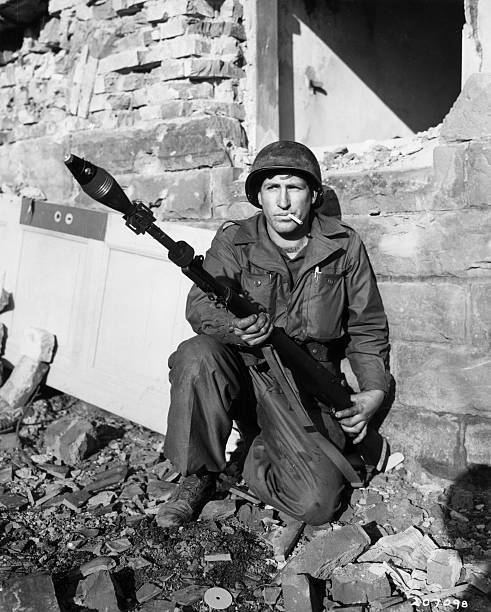
During World War II, the weapon system of the American infantry used rifle grenade launchers as a means of destruction, intermediate between hand grenades and the company 60-mm M2 mortar. Fragmentation and cumulative anti-tank rounds were developed for grenade launchers, as well as a number of adapters that made it possible to use various hand grenades as grenade launchers; later chemical rounds appeared.
The problem was that the shots themselves had some features and the resulting restrictions and application features. The M17 fragmentation round was a tang-mounted and impact-fuzed MK2 hand-held fragmentation grenade. Later, the M1 adapter was developed, which allowed the grenade launcher to fire a regular MK2 fragmentation grenade, but there was still no difference between it and the special M17 fragmentation grenade launcher.
And it was the MK2 grenade on the adapter that became the most common fragmentation shot for American rifle grenade launchers. That is, in fact, the result was a hand grenade that could fly further than one thrown using the muscular strength of a fighter, and at the same time with all the features of a fuse with a moderator (in the case of the “pineapple” on the adapter). For example, when firing a fragmentation grenade up the slope of a hill, the grenade, having fallen, could roll back to the grenade launcher.
The infantrymen at the front wanted something more powerful than a conventional fragmentation grenade, and the fuse was an impact fuse.
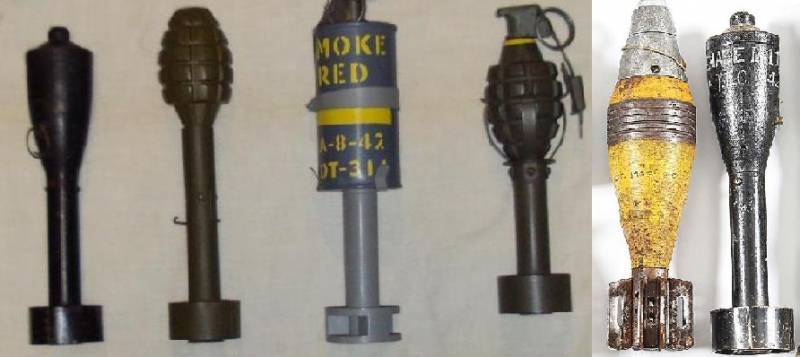
M11 practice round, M17 fragmentation round, smoke grenade on M2 adapter and MK2 fragmentation grenade on M1 adapter for firing from a rifle grenade launcher. And a 60 mm M49A2 mortar shell next to the same M11 training round... Feel the difference, as they say.
The idea, one might say, was in the air... Who first came up with the idea of trying to fire a 49-mm caliber M2A60 fragmentation mortar mine from a rifle grenade launcher? story is silent. But this was what was needed. Weight - 1,3 kg with 150 g of explosives inside.
For comparison: the MK2 grenade, which was actually the warhead of a standard fragmentation grenade launcher round, weighed a little more than half a kilogram and contained just over 50 grams of explosive. The increase in power was obvious.
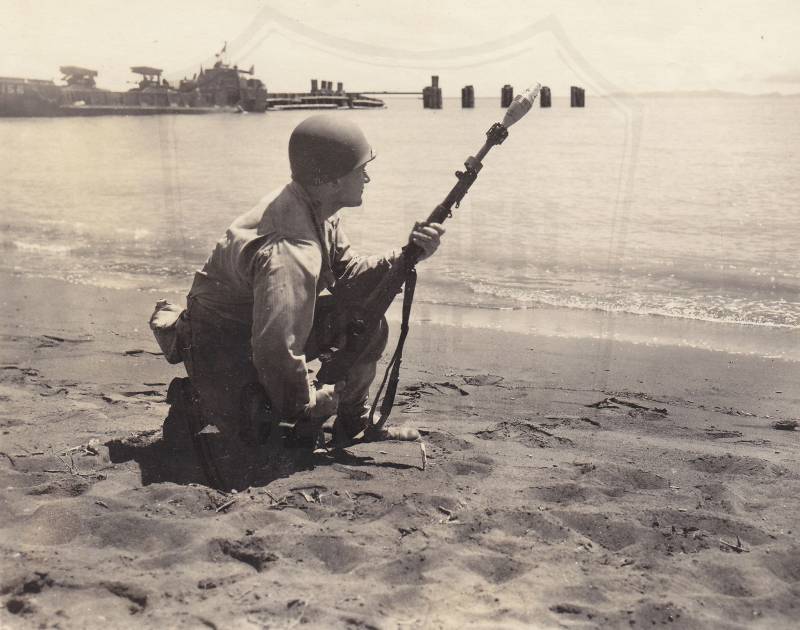
One of the first, if not the first, known photo of a “rifle mortar”, Australia, 1943.
At first, mortar shells were attached to an M1 adapter for a fragmentation grenade, fortunately the “antennae” of the adapter bent perfectly with the tools at hand. Sometimes wire was used for reliability. But then they found a much simpler and more technologically advanced way of making shots. The M9A1 cumulative grenade launcher round was disassembled, and the mortar mine was screwed onto the shank.
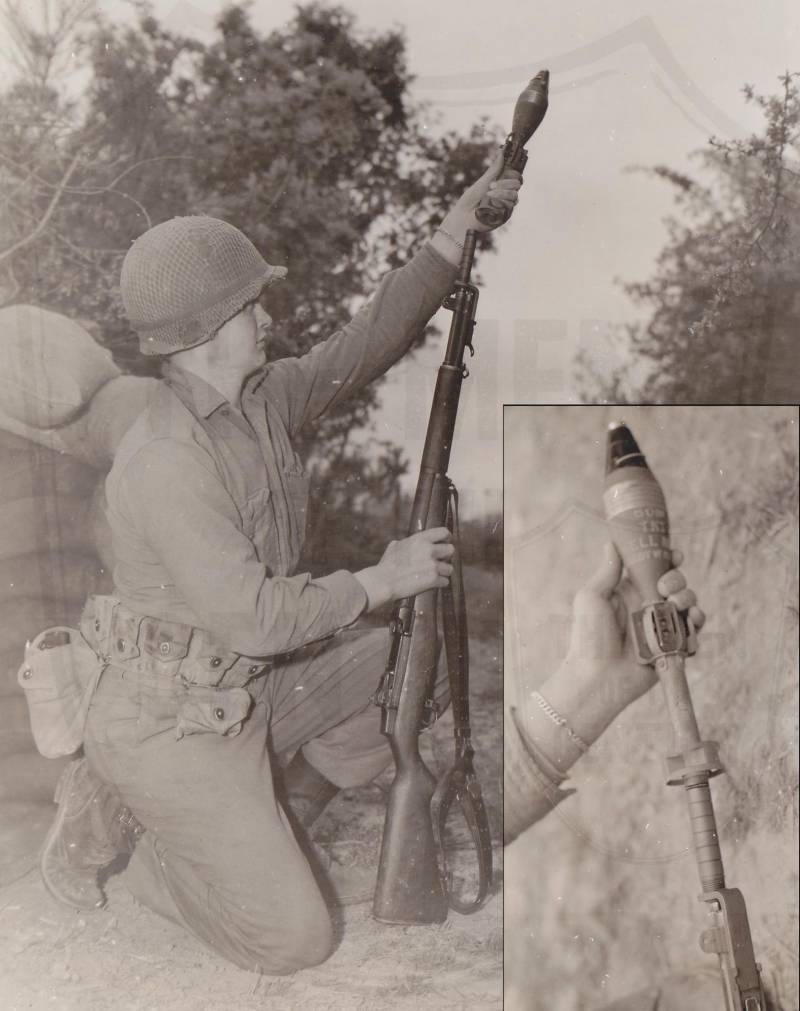
M49A2 mortar mine on an adapter for M1 hand grenades, M1 rifle with M7 rifle grenade launcher, 1944–1945.
The resulting fragmentation shot also had a number of limitations and application features.
First and most importantly: you could forget about shooting with the rifle resting on the shoulder, which was possible with standard grenade launcher shots. It was possible to shoot safely for the shooter’s health only by resting the butt of the rifle on the ground, wall, etc.
Also, such a “grenade” could not be fired from the M8 rifle grenade launcher, developed for the M1 carbine...
The lightweight carbine was simply not designed for such loads. The firing range turned out to be simply ridiculous and fluctuated within 100 meters. This was less than a standard fragmentation shot, but still greater than the throwing range of a grenade, but at the same time a full-fledged fragmentation mine from a company mortar was flying at the enemy. Considering that such an improvised grenade launcher was most often used in urban battles and in the jungle, the short range did not bother anyone.

A couple of frames from a video using a “mortar mine - rifle grenade launcher” pair somewhere in Europe, 1945.
It is unknown who authored the first grenade launcher shot with a mortar mine. Most likely, such improvisations appeared absolutely autonomously in the Pacific and European theaters of combat.
But the first documentary mention of such “experiments” dates back to 1943, and these were carried out by soldiers who had fought on Guadalcanal and were sent on vacation to Australia. In 1944, mention of this kind of alterations was already repeatedly found in various army documents and reports.
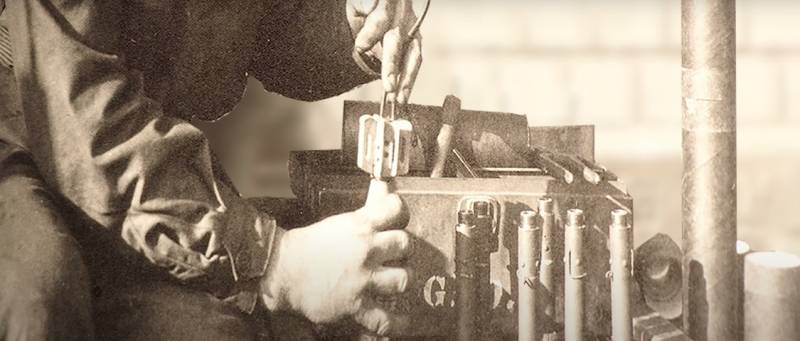
The process of small-scale production of mortar and grenade launcher rounds. An expelling charge is being removed from an M49A2 mine; ready-made shanks from disassembled M9 anti-tank rounds stand nearby.
In January 1944, a mention of a grenade launcher shot from a mortar mine appears in an official document of the US War Department - a technical bulletin, in fact a periodical publication of the ministry, describing, among other things, various examples of useful “front-line amateur performance”. It said that this kind of homemade work was unofficial, should be considered only as an emergency measure and used only with the knowledge of the command.
In fact, this was a recognition of the fact that such amateur activity could be useful, and with the help of an official army document, information about yesterday's handicraft was brought to a wide range of army ranks.
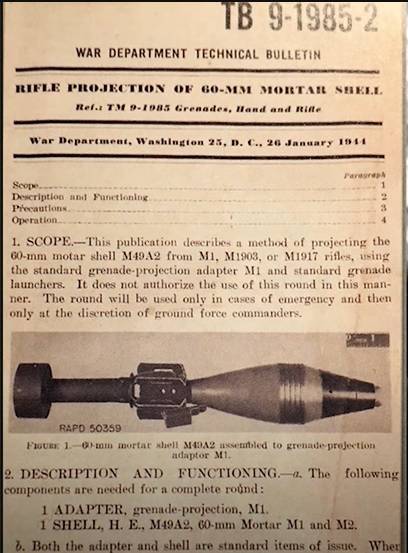
A document that introduced front-line homemade products to wide circles of the army community at the beginning of 1944
A veteran of the battles of the Ardennes, the official historian of the US Army and the author of classic memoirs about World War II, Charles B. MacDonald, wrote in his book “Company Commander” that grenade rounds from mortar mines had only one drawback - they were always there few.
At the end of World War II, the development of fragmentation rounds for rifle grenade launchers was forgotten. The military budget has decreased by more than 10 times, and there is no time left.
In addition, already at the end of World War II, the American infantry had a new means of destroying enemy infantry - a recoilless rifle. By the time the conflict broke out on the Korean Peninsula, the American arsenal already had similar guns with a caliber of up to 75 millimeters. And after the end of the war in Korea, the development of a full-fledged 40 mm caliber hand grenade launcher began.
The age of rifle grenade launchers was coming to an end. But that's a completely different story.
Information